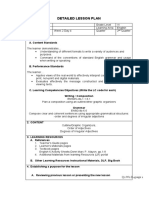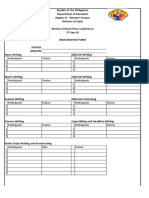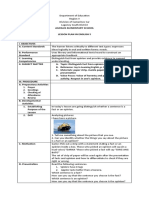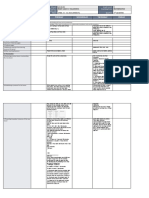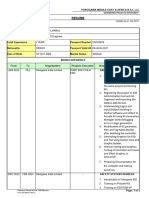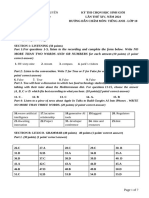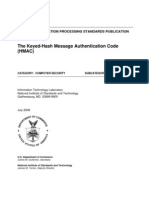0 ratings0% found this document useful (0 votes)
108 viewsStrategies For Supporting Reading Andf Language Learners-Clra Results
Strategies For Supporting Reading Andf Language Learners-Clra Results
Uploaded by
connie saunarThis document outlines an action plan for a school's 2021 Reading Month celebration with the theme "Every Child Reads Despite Pandemic Challenges." The plan includes attending the division kick-off, informing parents of remedial reading activities, training teachers on reading techniques, orienting parents on remedial activities, and distributing reading materials to develop skills and stimulate reading love. The objectives are supported by specific activities, dates, involved persons, and success indicators to guide implementation and evaluation of the plan.
Copyright:
© All Rights Reserved
Available Formats
Download as PDF, TXT or read online from Scribd
Strategies For Supporting Reading Andf Language Learners-Clra Results
Strategies For Supporting Reading Andf Language Learners-Clra Results
Uploaded by
connie saunar0 ratings0% found this document useful (0 votes)
108 views27 pagesThis document outlines an action plan for a school's 2021 Reading Month celebration with the theme "Every Child Reads Despite Pandemic Challenges." The plan includes attending the division kick-off, informing parents of remedial reading activities, training teachers on reading techniques, orienting parents on remedial activities, and distributing reading materials to develop skills and stimulate reading love. The objectives are supported by specific activities, dates, involved persons, and success indicators to guide implementation and evaluation of the plan.
Original Description:
this file is a useful tool in discussing the strategies in reading especially in primary level.
Original Title
STRATEGIES FOR SUPPORTING READING ANDF LANGUAGE LEARNERS-CLRA RESULTS
Copyright
© © All Rights Reserved
Available Formats
PDF, TXT or read online from Scribd
Share this document
Did you find this document useful?
Is this content inappropriate?
This document outlines an action plan for a school's 2021 Reading Month celebration with the theme "Every Child Reads Despite Pandemic Challenges." The plan includes attending the division kick-off, informing parents of remedial reading activities, training teachers on reading techniques, orienting parents on remedial activities, and distributing reading materials to develop skills and stimulate reading love. The objectives are supported by specific activities, dates, involved persons, and success indicators to guide implementation and evaluation of the plan.
Copyright:
© All Rights Reserved
Available Formats
Download as PDF, TXT or read online from Scribd
Download as pdf or txt
0 ratings0% found this document useful (0 votes)
108 views27 pagesStrategies For Supporting Reading Andf Language Learners-Clra Results
Strategies For Supporting Reading Andf Language Learners-Clra Results
Uploaded by
connie saunarThis document outlines an action plan for a school's 2021 Reading Month celebration with the theme "Every Child Reads Despite Pandemic Challenges." The plan includes attending the division kick-off, informing parents of remedial reading activities, training teachers on reading techniques, orienting parents on remedial activities, and distributing reading materials to develop skills and stimulate reading love. The objectives are supported by specific activities, dates, involved persons, and success indicators to guide implementation and evaluation of the plan.
Copyright:
© All Rights Reserved
Available Formats
Download as PDF, TXT or read online from Scribd
Download as pdf or txt
You are on page 1of 27
S T R AT E G I E S F O R S U P P O R T I N G
READING AND LANGUAGE
LEARNERS
- C R L A R E S U LT S
OBJECTIVES:
• To determine which reading strategies we should apply for our learners
with different learning needs.
• To make an action plan on reading intervention for struggling readers.
https://youtu.be/0Hhnbr7D0n0
• To develop an intervention materials to improve the reading skills of the
learners
AC T I V I T Y # 1
Answer the following:
1. What problem/s have you encountered in teaching reading during
this pandemic?
2. What reading strategy/ies you usually apply in your class?
How often do you apply those strategy/ies?
3. What materials did you provide for your learners?
Is it effective to improve the reading skills of your learners?
What strategy should use?
1) CHUNKING
This strategy involves your child breaking words into
manageable ‘chunks’ to sound out, rather than sounding out each
individual letter.
• The stronger your child is in word families and general letter/sound,
the more successful they will be in using this strategy.
• Have your child look at the word to find letters combinations that they
know. Once they have found one (or more), encourage the use of
fingers to isolate the ‘chunks’.
2) WHAT’S THE FIRST SOUND?
• In this strategy, the reader gets his/her lips ready to say the
first sound, and tries to ‘pop’ it out. Often this strategy needs
to be accompanied with ‘look at the pictures’. For
example: The big d-d-d-dinosaur. Combining this strategy
with ‘look at the pictures’ means the reader is having an
educated guess.
3) LOOK AT THE PICTURES
• It is important to stress the need for children to have the confidence and ability to
use more than one reading strategy to solve a word/words. This is particularly
evident when using ‘Look at the Pictures’ strategy. When your child gets a clue
from an illustration, encourage cross-checking using a second strategy.
For example:
• “That looks like a sheep in the picture, now let’s check the word. What letters
would the word have to start with? That’s right, ‘sh’. Does the word start with ‘sh’?
No? It starts with an ‘L’. ‘L’ says ‘lll’. What word could it be? Let’s look back at the
picture. It’s a l-l-lamb.”
4) VISUALIZING
When you use the words in a
story or book to make a
picture in your mind, you are
visualizing. Teaching students
to use the visualization
reading strategy is an
important skill for them to use
for reading comprehension.
5) PRE-READING STRATEGIES
• These strategies aims to get children ready to
read a book. We want to give children the best
chance to be successful when reading a book,
and these pre-reading strategies does just
that. Before reading a book, have your child
do a ‘walkthrough’ of the book.
Engage with the book before reading
While ‘walking through’ the book, get your learner thinking about:
•What characters can I see?
•What is the setting of the story?
•What might the problem of the story be?
•How might the problem be solved?
Ask your learner:
•What kind of book do you think this is? Is it a story? Or is it an information book? (introduce
the terminology ‘fiction’ and ‘non-fiction’).
•Why do you think it’s a (fiction/non-fiction) book?
•What words do you think we will see in this book? (make a list of them- this will help when
your child comes to reading those trickier words).
6) ACTIVATING PRIOR KNOWLEDGE
• This strategy helps readers
bring meaning and connections
to their reading. Thinking
about you already know is
useful because it gives you
base to build new knowledge.
7) MODEL
• Modelled reading (reading to or
reading aloud) involves students
listening to a text read aloud by
the teacher. The teacher models
skilled reading behaviour,
enjoyment and interest in a range
of different styles of writing and
types of text.
8) REREADING
• Rereading is often used with students who
are struggling readers or students who
have a learning disability, but it can be a
useful strategy for any young reader
• Rereading helps students develop greater
accuracy in reading. When students
reread, words that they may have
struggled to decode on a first reading
become increasingly easier to parse
9) SETTING A PURPOSE
• Setting a purpose for reading helps
keep students focused and engaged
while reading, and gives them a
mission so that comprehension can be
reinforced.
• Reading with purpose motivates
children and helps students who
tend to rush, take their time reading
so they won't skip over key elements
in the text.
10) CONTEXT CLUES
• These are hints that the
author gives to help define
a difficult or unusual word.
• The clue may appear
within the same sentence
as the word to which it
refers or it may follow in
the next sentence.
11) EVALUATING
• Evaluating is a reading strategy
that is conducted during and after
reading. This involves encouraging
the reader to form opinions, make
judgments, and develop ideas from
reading. Teachers can create
evaluative questions that will lead
the student to make
generalizations about and critically
evaluate a text.
12) MONITOR
• It is important to plan and
monitor pupils' progress
throughout the academic year
so that teaching can be
adapted accordingly to get
the best possible outcomes for
each pupil.
USING TECHNOLOGY TO SUPPORT READING
• Technology can help teachers
provide more of the
individualized instruction that
children with reading
difficulties need.
• Use technology to enhance
traditional reading
experiences.
HOW TO TEACH THESE READING
S T R AT E G I E S ?
These strategies must be taught explicitly. Focus on one strategy at a time. For
each strategy:
• Explain: Talk to your child about it and explain what it means, how it’s used
and when it’s useful.
• Model: When reading to your child, use the strategy ‘out loud’. Use the
strategy as a competent reader to model what it should look/sound like.
• Support: Assist your child applying the strategy. Give feedback and make
adjustments as needed.
• Independent: Your child should then be able to use the strategies
independently. Continue to monitor the use.
Republic of the Philippines
Department of Education
Region V- Bicol
SCHOOL DIVISION OF LIGAO CITY
District 9
LIGAO WEST CENTRAL ELEMENTARY SCHOOL (B) Greenfield Ext.
Guilid, Ligao City
ACTION PLAN ON 2021 READING MONTH CELEBRATION
Theme: “Bawat Bata Bumabasa sa Kabila ng Hamon ng Pandemya.”
OBJECTIVE ACTIVITY DATE/TIME PERSONS INVOLVED SUCCESS INDICATOR
To support the 2021 Division Participate and attend Nov. 10, 2021 School Head, Reading Attendance
Reading Month Celebration Division Virtual Kick-Off Coordinators and Teachers. Documentation
Ceremony of 2021 Reading
Month Celebration
To inform the parents of the Information dissemination Nov. 22, 2021 Reading Coordinator, Attendance
conduct of remedial reading on remedial reading Teachers and Parents and Documentation and
activities for struggling activities through letters, pupils Narrative Report
learners group chat, text message
and voice call.
To equip the teachers with Capacitate the teachers on Nov 23, 2021 School Head, Reading Narrative Report
knowledge and skills on the the different reading Coordinator, Teachers Documentation
different reading techniques techniques for beginning Video lesson for beginning
for beginning readers. readers/Remedial Reading reading techniques and
strategies.
To give orientation to the Orientation of parents on Nov. 24, 2021 School Head, Reading Narrative Report
parents on the conduct of Remedial Reading Activities Coordinator, Teachers and Documentation
remedial reading activities Parents
for struggling readers.
To develop the reading skills Distribution of Reading Nov. 24, 2021 Reading Coordinator, Attendance
and stimulate learners love materials suited to the Teachers and Parents Documentation
for reading. learners
You might also like
- Collins Cambridge Checkpoint English Coursebook 8 Answers PDFDocument5 pagesCollins Cambridge Checkpoint English Coursebook 8 Answers PDFbelinda chikanda33% (6)
- 1 1 Anecdotal Notes From Reading GroupsDocument4 pages1 1 Anecdotal Notes From Reading Groupsapi-352850391No ratings yet
- WinPLC Analyzer enDocument83 pagesWinPLC Analyzer enbolsdrinkerNo ratings yet
- Huawei: H12-211 ExamDocument161 pagesHuawei: H12-211 ExamThomaz Stepheson de Souza GomesNo ratings yet
- Explicit InstructionDocument46 pagesExplicit InstructionJoan Pedaria Garong100% (1)
- Explicit Instruction Learning Model (Group 4)Document12 pagesExplicit Instruction Learning Model (Group 4)Hilda SyadiqahNo ratings yet
- Lesson Plan in English 5Document5 pagesLesson Plan in English 5Allyza OrtizNo ratings yet
- Performance-Based Test: Jerson Adrian NiergaDocument44 pagesPerformance-Based Test: Jerson Adrian NiergaJerson Adrian NiergaNo ratings yet
- RUMBAOA ANNOTATION AND TRF For COT2Document11 pagesRUMBAOA ANNOTATION AND TRF For COT2PhritsBassiNo ratings yet
- Final Juvz PortfolioDocument140 pagesFinal Juvz PortfolioNylvel Sesbino GonzalesNo ratings yet
- FinalDocument52 pagesFinalRhea AlayonNo ratings yet
- DO s2020 018.deped - Order.memoDocument6 pagesDO s2020 018.deped - Order.memobenz cadiongNo ratings yet
- Dll-Q2-Week 4Document2 pagesDll-Q2-Week 4Marife GaspiNo ratings yet
- ICT Training and Development ChecklistDocument1 pageICT Training and Development ChecklistNieves SantosNo ratings yet
- DLP VerbDocument3 pagesDLP VerbAngela MacaraegNo ratings yet
- PDF Final - Ls1eng - Simple Tenses of The VerbsDocument36 pagesPDF Final - Ls1eng - Simple Tenses of The Verbsjoel.cantuba0001No ratings yet
- Remediation PlanDocument2 pagesRemediation PlanANNALYN MAYNIGONo ratings yet
- Matrix of Curriculum Standards (Competencies), With Corresponding Recommended Flexible Learning Delivery Mode and Materials Per Grading PeriodDocument2 pagesMatrix of Curriculum Standards (Competencies), With Corresponding Recommended Flexible Learning Delivery Mode and Materials Per Grading PeriodaldeNo ratings yet
- Grade 4 DLL Q1 Week-8Document29 pagesGrade 4 DLL Q1 Week-8Dinalyn Alcera LongcopNo ratings yet
- 21st Century Literacy Skills - AADocument48 pages21st Century Literacy Skills - AAJay Louie JarbonidoNo ratings yet
- Factors To Consider When Selecting Reading Materials For LearnersDocument10 pagesFactors To Consider When Selecting Reading Materials For Learnerskwadwooseibonsu11No ratings yet
- Redeveloped Division Initiated Self-Learning Module: Department of Education - Division of PalawanDocument12 pagesRedeveloped Division Initiated Self-Learning Module: Department of Education - Division of PalawanMary Joy CasoyNo ratings yet
- Lesson 6Document51 pagesLesson 6Arnel BilangonNo ratings yet
- Form 9Document8 pagesForm 9JEZEBEL ASNENo ratings yet
- Solonon Solo Tos 2nd P.test in English 2022 2023 ElizaDocument3 pagesSolonon Solo Tos 2nd P.test in English 2022 2023 Elizamarlon novisioNo ratings yet
- COT 2 LE 2021-2022 Copy 2Document8 pagesCOT 2 LE 2021-2022 Copy 2Shiela Peregrin BagsitNo ratings yet
- ALternative Learning SystemDocument11 pagesALternative Learning SystemLeonor BagnosNo ratings yet
- 1st COT (Autosaved) For IPDocument10 pages1st COT (Autosaved) For IPMa. Donna GeroleoNo ratings yet
- DLP English 6 w2d4Document7 pagesDLP English 6 w2d4PRESTENENo ratings yet
- Schools Division Office: ENG4Q1W2D1Document7 pagesSchools Division Office: ENG4Q1W2D1Zel MayNo ratings yet
- Apply Knowledge of Content Within and AcDocument36 pagesApply Knowledge of Content Within and AcROSANA MARQUEZNo ratings yet
- Pdf-Final Ls1eng Adverbs of Place and TimDocument21 pagesPdf-Final Ls1eng Adverbs of Place and Timjoel.cantuba0001No ratings yet
- Module 17Document40 pagesModule 17Leonora Dela CruzNo ratings yet
- GRADES 1 To 12 Daily Lesson Log Monday Tuesday Wednesday Thursday FridayDocument7 pagesGRADES 1 To 12 Daily Lesson Log Monday Tuesday Wednesday Thursday FridayAnonymous 7aTLgycYONo ratings yet
- S4T2W4Document4 pagesS4T2W4Mary Ann AbundoNo ratings yet
- DLL Q2 Week2 Day3Document11 pagesDLL Q2 Week2 Day3Manila Hankuk AcademyNo ratings yet
- Detailed Research Lesson Plan Grade Level Quarter/Domain Week &day No. Page NoDocument10 pagesDetailed Research Lesson Plan Grade Level Quarter/Domain Week &day No. Page NoGlenn OthersNo ratings yet
- DI Session GuideDocument3 pagesDI Session GuideLOLITA DE LEONNo ratings yet
- Classroom Observation ToolDocument3 pagesClassroom Observation ToolYna Rhyss Erald RomsNo ratings yet
- Grade 2 DLL Math 2 q4 Week 1Document10 pagesGrade 2 DLL Math 2 q4 Week 1MARY KENNETH SILVOSANo ratings yet
- Template For Classifying Learners Grades Per Learning Area in Grades 1 12Document2 pagesTemplate For Classifying Learners Grades Per Learning Area in Grades 1 12Aubrey SomozaNo ratings yet
- English Q2 Week 5 Day 2Document47 pagesEnglish Q2 Week 5 Day 2Meloida BiscarraNo ratings yet
- English 5 - Connotation and Denotation - w8Document21 pagesEnglish 5 - Connotation and Denotation - w8Jonalyn Adalem TugganaNo ratings yet
- PPST Module 3 - Management of Learners BehaviorDocument10 pagesPPST Module 3 - Management of Learners BehaviorMarvic ReyesNo ratings yet
- DLL Mapeh-5 Q2Document99 pagesDLL Mapeh-5 Q2Israel Del MundoNo ratings yet
- DLL English 10 - Module 1 - Lesson 4 - Motivational VideoDocument7 pagesDLL English 10 - Module 1 - Lesson 4 - Motivational VideoJennifer OestarNo ratings yet
- JOHN LUAY - Final - MATATAG-WAP - May2024Document6 pagesJOHN LUAY - Final - MATATAG-WAP - May2024John B. LuayNo ratings yet
- DSPC Reg FormDocument4 pagesDSPC Reg FormKyros's MomNo ratings yet
- Obj 1-3Document14 pagesObj 1-3jinaNo ratings yet
- DLP English Q2 W5-Dec.9Document7 pagesDLP English Q2 W5-Dec.9Rosevyl Azas CadayNo ratings yet
- DLL - English 4 - Q2 - W1Document5 pagesDLL - English 4 - Q2 - W1Mikkey Jane Delgra100% (2)
- Group1 Compiled ReportDocument187 pagesGroup1 Compiled ReportERVIC VICENTENo ratings yet
- Innovation Project ProposalDocument9 pagesInnovation Project ProposalLengie Canacan MontejoNo ratings yet
- Cot DLP Eng 4THDocument15 pagesCot DLP Eng 4THSuzanne Asuncion100% (1)
- INTERVENTION PLAN PER ENGLISH - AshguifilesDocument2 pagesINTERVENTION PLAN PER ENGLISH - AshguifilesBernadette CadizNo ratings yet
- Sample Catch Up Plan FinalDocument6 pagesSample Catch Up Plan Finalglaidel piolNo ratings yet
- Action Research Presentation TemplateDocument9 pagesAction Research Presentation TemplateJoel HinayNo ratings yet
- Positive Discipline in Everyday Teaching: What Is Positive Discipline? How Is Positive Discipline Practised?Document4 pagesPositive Discipline in Everyday Teaching: What Is Positive Discipline? How Is Positive Discipline Practised?Avi LunaNo ratings yet
- Classroom ObservationDocument6 pagesClassroom ObservationNabila Salwa FatiyaNo ratings yet
- School Library Collection InventoryDocument3 pagesSchool Library Collection InventoryCj ReyesNo ratings yet
- Classroom Observation Report Using Danielson LanguageDocument3 pagesClassroom Observation Report Using Danielson LanguageBidita RahmanNo ratings yet
- Lesson PlanDocument5 pagesLesson PlanHannah Milante OrtineroNo ratings yet
- Action Plan Reading Month CelebDocument2 pagesAction Plan Reading Month Celebconnie saunarNo ratings yet
- Action Plan Reading Month CelebDocument2 pagesAction Plan Reading Month Celebconnie saunarNo ratings yet
- Crla Action Plan FinalDocument2 pagesCrla Action Plan Finalconnie saunar100% (5)
- Narrative On INSET2022Document9 pagesNarrative On INSET2022connie saunarNo ratings yet
- School Crla Monitoring ToolDocument1 pageSchool Crla Monitoring Toolconnie saunarNo ratings yet
- LP CONS COT 2 (Telling Time)Document5 pagesLP CONS COT 2 (Telling Time)connie saunar100% (1)
- Narrative & Documentation in 2nd SLAC (Jan 24-25,2022)Document3 pagesNarrative & Documentation in 2nd SLAC (Jan 24-25,2022)connie saunarNo ratings yet
- MAPS™ IMS Test SuiteDocument8 pagesMAPS™ IMS Test SuiteRanjeet SinghNo ratings yet
- CBF 02 GuideDocument3 pagesCBF 02 Guidehidayat060789No ratings yet
- Reed Ass FaithDocument4 pagesReed Ass FaithReseNo ratings yet
- Instagram Engineering TechnologyDocument16 pagesInstagram Engineering TechnologyPosess MogapiNo ratings yet
- How Have You BeenDocument2 pagesHow Have You BeenKhaireen IbrahimNo ratings yet
- 1.4 Phrasal Verbs Set 2 Example Sentences PDFDocument2 pages1.4 Phrasal Verbs Set 2 Example Sentences PDFRawsht MuradyNo ratings yet
- 1906 1UR0 2H Speaking Picture Candidate BookletDocument20 pages1906 1UR0 2H Speaking Picture Candidate BookletShahram 7FNo ratings yet
- DLL - Mathematics 5 - Q3 - W9.1Document9 pagesDLL - Mathematics 5 - Q3 - W9.1Mary Grace Amador Corto-VillanuevaNo ratings yet
- Good Thesis Statements For OthelloDocument5 pagesGood Thesis Statements For Othelloafloihzesdawig100% (2)
- Good Morning ActivityDocument3 pagesGood Morning ActivityCarito MorenoNo ratings yet
- Embedded (Practical)Document18 pagesEmbedded (Practical)Devika KachhawahaNo ratings yet
- Understanding Classification-Exemplification Texts: Group 1Document6 pagesUnderstanding Classification-Exemplification Texts: Group 1K IdolsNo ratings yet
- Javaserver Pages Standard Tag Library (JSTL) Syntax ReferenceDocument2 pagesJavaserver Pages Standard Tag Library (JSTL) Syntax ReferencejoselesNo ratings yet
- Exam ICT 2nd QuarterDocument4 pagesExam ICT 2nd QuarterKurtville YambagonNo ratings yet
- 2018 - Course Syllabus SuperLearner V2.0 Skillshare PDFDocument17 pages2018 - Course Syllabus SuperLearner V2.0 Skillshare PDFABDUL AHADNo ratings yet
- O Mankind Worship Your Lord AllaahDocument3 pagesO Mankind Worship Your Lord AllaahAminuNo ratings yet
- Devesh Kumar YMA ResumeDocument3 pagesDevesh Kumar YMA ResumeArivu ChelvamNo ratings yet
- Group1-2-4pm-MW WITH ANSWERSDocument5 pagesGroup1-2-4pm-MW WITH ANSWERSJoyce BaclayonNo ratings yet
- ANH 10_HDCDocument7 pagesANH 10_HDCuachu2708No ratings yet
- WeAccess Viewing Enrolment FormsDocument11 pagesWeAccess Viewing Enrolment FormsGlydel Macasa BantoloNo ratings yet
- Saamiyaridam Pillai Varam-Part 1 (Rassy Camren)Document376 pagesSaamiyaridam Pillai Varam-Part 1 (Rassy Camren)Rassy CamrenNo ratings yet
- SS Mu 3.1 Lores PDFDocument19 pagesSS Mu 3.1 Lores PDFThakurainChaudharyNo ratings yet
- American Association of Teachers of Slavic and East European LanguagesDocument4 pagesAmerican Association of Teachers of Slavic and East European LanguagesAhmet Kargin100% (1)
- Tugas 2Document3 pagesTugas 2Goji NaticNo ratings yet
- Hmac Fips 198 1 FinalDocument13 pagesHmac Fips 198 1 Finaloldsail2No ratings yet
- TN Gazette 47 of 2013 Part VI Section 4Document84 pagesTN Gazette 47 of 2013 Part VI Section 4BrunoNo ratings yet
- Mastering Power ShellDocument567 pagesMastering Power ShellalwaysharshaNo ratings yet




























